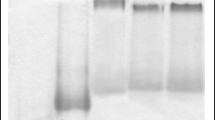Abstract
Current cancer treatments still remain ineffective and cause side effects which ruinously affect healthy cells. Among new promising anticancer drugs, special attention is paid to the ribonucleases (RNases) which possess selective cytotoxicity against malignant cells. It is found that besides enzymatic activity conformational state of RNase molecules plays a role in the anticancer activity. Balnase, a new RNase from Bacillus altitudinis, is a close homolog of Bacillus pumilus RNase (binase) which selectively kills malignant cells expressing oncogenes KIT, ras, AML1/ETO, and FLT3. Earlier, homogeneous sample of balnase was obtained. Here, we have characterized structural organization of balnase. It was shown that it is a natural dimer. The enzyme has the same conformational state as binase but balnase dimers are less stable.

Similar content being viewed by others
References
Mitkevich, V., Ilinskaya, O., Makarov, A. (2015). Antitumor RNases: killer’s secrets. Cell Cycle, 14, 931–932.
Mitkevich, V., Burnysheva, K., Ilinskaya, O., Pace, C., Makarov, A. (2014). Cytotoxicity of RNase Sa to the acute myeloid leukemia Kasumi-1 cells depends on the net charge. Oncoscience, 11, 738–744.
Ilinskaya, O., Dreyer, F., Mitkevich, V., Shaw, K., Pace, C., Makarov, A. (2002). Changing the net charge from negative to positive makes ribonuclease Sa cytotoxic. Protein Science, 11, 2522–2525.
Makarov, A., Kolchinsky, A., Ilinskaya, O. (2008). Binase and other microbial RNases as potential anticancer agents. Bioessays, 8, 781–790.
Ardelt, W., Ardelt, B., Darzynkiewicz, Z. (2009). Ribonucleases as potential modalities in anticancer therapy. European Journal of Pharmacology, 625, 181–189.
Zuo, Y., & Deutscher, M. (2002). Mechanism of action of RNase T. II. A structural and functional model of the enzyme. The Journal of biological chemistry, 277, 50160–50164.
Garvie, C., Vasanthavada, K., Xiang, Q. (2013). Mechanistic insights into RNase L through use of an MDMX-derived multi-functional protein domain. Biochimica et Biophysica Acta, 1834, 1562–1571.
Lin, R., Chien, H., Lin, S., Chang, B., Yu, H., Tang, W., et al. (2013). MCPIP-1 ribonuclease exhibits broad-spectrum antiviral effects through viral RNA binding and degradation. Nucleic Acids Research, 41, 3314–3326.
Gotte G., Mahmoud Helmy A., Ercole C., Spadaccini R., Laurents D., Donadelli M., Picone D. (2012) Double domain swapping in bovine seminal RNase: formation of distinct N- and C-swapped tetramers and multimers with increasing biological activities. PloS One 7: doi:10.1371/journal.pone.0046804
Ilinskaya, O., Decker, K., Koschinski, A., Dreyer, F., Repp, H. (2001). Changing the net charge from negative to positive makes ribonuclease Sa cytotoxic. Toxicology, 156, 101–107.
Mitkevich, V., Petrushanko, I., Kretova, O., Zelenikhin, P., Prassolov, V., Tchurikov, N., et al. (2010). Oncogenic c-kit transcript is a target for binase. Cell Cycle, 9, 2674–2678.
Mitkevich, V., Petrushanko, I., Spirin, P., Fedorova, T., Kretova, O., Tchurikov, N., et al. (2011). Sensitivity of acute myeloid leukemia Kasumi-1 cells to binase toxic action depends on the expression of KIT and AML1-ETO oncogenes. Cell Cycle, 10, 4090–4097.
Mitkevich, V., Schulga, A., Trofimov, A., Dorovatovskii, P., Goncharuk, D., et al. (2013). Structure and functional studies of the ribonuclease binase Glu43Ala/Phe81Ala mutant. Acta Cryst D Biol Crystallogr, 69, 991–996.
Dudkina, E., Kayumov, A., Ulyanova, V., Ilinskaya, O. (2014). New insight into secreted ribonuclease structure: binase is a natural dimer. PloS One, 12, e115818.
Dementiev, A., Orlov, V., Shlyapnikov, S. (1993). Complete primary structure of an extracellular ribonuclease of Bacillus thuringiensis. Russ J Bioorganic Chem, 19, 853–861.
Dudkina, E., Ulyanova, V., Shah, M. R., Khodzhaeva, V., Dao, L., Vershinina, V., et al. (2016). Three-step procedure for preparation of pure Bacillus altitudinis ribonuclease. FEBS Open Bio, 6, 24–32.
Ilinskaya, O., Karamova, N., Ivanchenko, O., Kipenskaya, L. (1996). SOS-inducing ability of native and mutant microbial ribonucleases. Mutation Research, 354, 203–209.
Laemmli, U. (1970). Cleavage of structural proteins during the assembly of the head of bacteriophage T4. Nature, 227, 680–685.
Acknowledgments
The study was performed within the Russian Government Program of Competitive Growth of Kazan Federal University and was supported by the Russian Science Foundation (project no. 141400522).
Author information
Authors and Affiliations
Corresponding author
Rights and permissions
About this article
Cite this article
Dudkina, E., Ulyanova, V. & Ilinskaya, O. Balnase, a New Dimer-Forming Ribonuclease from Bacillus altitudinis . BioNanoSci. 7, 127–129 (2017). https://doi.org/10.1007/s12668-016-0305-y
Published:
Issue Date:
DOI: https://doi.org/10.1007/s12668-016-0305-y




